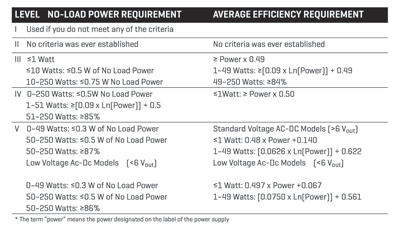Here’s how to traverse the mandates enacted to improve external power supply efficiency
BY JEFF SCHNABEL
CUI
www.cui.com
As the monetary and environmental costs of power continue to rise, consumers, governments, and corporations alike are increasingly placing a microscope on areas of energy waste. External power supplies have been in the cross hairs for many years now, and rightly so. In the early 1990s, it was estimated that there were more than one billion external power supplies active in the United States alone.
The efficiency of these power supplies, mainly utilizing linear technology, could be as low as 50% and still draw power when the application was turned off or not even connected to the power supply (referred to as “no-load” condition). Experts calculated that without efforts to increase efficiencies and reduce “no-load” power consumption, external power supplies would account for around 30% of total energy consumption in less than 20 years.
As early as 1992, the US Environmental Protection Agency started a voluntary program to promote energy efficiency and reduce pollution that eventually became the Energy Star program. Since the first mandatory regulation was enacted by the California Energy Commission (CEC) in 2004, the global regulatory environment surrounding the legislation of external power supply efficiency and no-load power draw has rapidly evolved. Figure 1 shows a graphical snapshot of this turbulent global environment over the past decade:

Fig. 1: The global regulatory environment surrounding the legislation of external power supply efficiency and no-load power draw has rapidly evolved in the past decade
Confused? You’re not the only one! As different countries and regions enact stricter requirements and move from voluntary to mandatory programs, it has become vital that corporations who design external power supplies into their products continually track the most recent developments to ensure compliance and avoid costly delays or fines.
While many countries are establishing voluntary programs harmonized to the international efficiency marking protocol system first established by Energy Star, the following countries and regions now have laws in place mandating that all external power supplies shipped across their borders meet the specified efficiency level:
Mandatory Efficiency Levels
United States Level IVCanada Level IVEuropean Union Level V
Today, Level V will meet or exceed the requirements of any governing body around the globe. Although the European Union is currently the only governing body to enforce compliance to the Level V standard, most external power supply manufactures are adjusting their product portfolios to meet these requirements. The adjustments are a direct response to the needs of OEM’s to have a universal power supply platform for their products that ship globally.
Digging deeper, Table 1 summarizes the performance thresholds for each efficiency level as they were established over time.

Table 1: Level V performance threshold for each efficiency level
The internationally approved test method for determining efficiency has been published by the IEC as AS/NZS 4665 Part 1 and Part 2. The approach taken in order to establish efficiency level is to measure the input and output power at 4 defined points: 25%, 50%, 75%, and 100% of rated power output. Data for all four points are separately reported as well as an arithmetic average active efficiency across all four points.
It is important to note that not all external power supplies are treated the same and exemptions exist in both the United States and the European Union.
In the U.S., Congress has written provisions into section 301 of EISA 2007 that exclude some types of external power supplies. These are devices that:
Require Federal Food and Drug Administration listing and approval as a medical device in accordance with section 513 of the Federal Food, Drug, and Cosmetic Act (21 U.S.C. 360c).Power the charger of a detachable battery pack or charges the battery of a product that is fully or primarily motor operated.Are made available as a service part or spare part by the manufacturer of an end-product that was produced before July 1, 2008 for which the external power supply was the primary load. Power supplies used for this purpose can be manufactured after July 1, 2008.
The European Union has instituted similar exemptions to the United States. External power supplies for medical devices, battery chargers, and service products are exempt. In addition, an exemption exists for low voltage EPS devices. Low voltage external power supply means a unit with a nameplate output voltage of
Moving forward
It is almost a certainty that Level V is not the end of the line for mandated power supply improvements as technologies advance and the cost of energy continues to rise. The U.S. Department of Energy (DOE), for example, has issued a Notice of Proposed Rulemaking (NOPR) that would lay out the first mandatory regulations for external battery chargers and further tighten regulations on external power supplies.
In what would effectively become the “Level VI” efficiency standard, the proposal on the table would mandate no-load efficiencies down to 0.1 W for external power supplies ranging from 1 to 49 W, boost mandatory average efficiency by about 1%, and set standards for models with power ratings above 250 W for the first time.
Moving beyond the mandated government regulations, many OEMs are now starting to demand “greener” power supplies as a way to differentiate their end-products, driving efficiencies continually higher and even pushing the implementation of control technologies that in some cases eliminates no-load power consumption altogether. In early 2010, CUI Inc began exclusively manufacturing Level V external power supplies across their 2.5 to 250-W external power supply product line.
Today, we continue to look for ways to implement the latest energy saving technologies into our external power supplies, allowing our customers to stay one step ahead of current and future regulations. You can view all Level V–compliant power supplies from CUI at www.cui.com/Catalog/Power/AC-DC_Power_Supplies/External. ■

Advertisement
Learn more about CUI Inc





